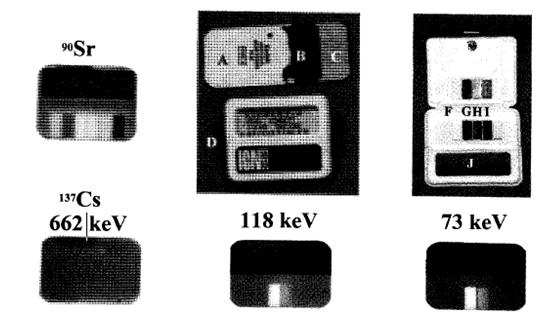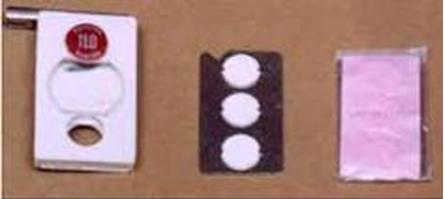Personnel Monitoring
Home > Radiation Protection and Quality Assurance > Radiation Protection > Personnel Monitoring
Radiation workers are assigned with Personal radiation monitoring devices or dosimeters (PMDs) by the Environment, Health and Safety (EHS) through the Radiation Safety Office to monitor their exposure. The PMDs are badges that detect and measure an employee's cumulative dose of exposure to x-rays, gamma radiation, neutron or beta particles. They can be whole body dosimeters, extremity dosimeters or pocket dosimeters depending on the source and amount of exposure, bearing the individual assignee’s name, date of the monitoring period and a unique identification number. Hence they should never be shared. They are collected monthly or quarterly and the reported doses are reviewed by an EHS Radiation Safety team and reported to the employer.
A radiation worker must wear the dosimeter while using ionizing radiation in the course of their employment or else may be fined. If the worker is required to wear a lead gown during the course of their duties, the PMD should be worn under the gown. After work the PMD should be stored at a safe place, away from the sources of radiation or heat.
When the defined issuing period has passed, all personal monitoring devices must be returned to the service provider for measurement. The PMDs that have not been issued or worn must also be returned to the service provider. New monitoring devices are sent to the institution for the new monitoring period.
NCRP Recommendations for Personnel Monitoring
National Council on Radiation Protection and Measurements (NCRP), formerly the National Committee on Radiation Protection and Measurements is a USA organization that seeks to formulate and widely disseminate information, guidance and recommendations on radiation protection and measurements which represent the consensus of leading scientific thinking.
It has established maximum safe allowable exposure limits as maximum permissible dose (MPD) to the radiation workers. The goal is not to reduce exposure to zero or near zero levels but rather to reduce levels to ALARA (As Low As Reasonably Achievable) (as defined in Nuclear Regulatory Commission (NRC) Code of Federal Regulations (part 10 CFR 20.1003)).
The NCRP recommendations are as follows:
- Occupational exposure limit is 50mSv per year
- Public exposure 5mSv per year
- Embryo/ fetal exposure 0.5mSv per month or 5mSv for 9 months as established by NRC regulations at 10 CFR 20.
The aim of personnel monitoring is,
1. monitor and control individual doses regularly in order to ensure compliance with the stipulated dose limits
2. report and investigate over exposures and recommend necessary remedial measures urgently
3. Maintain life time cumulative dose records of the users of the service.
Hence, the radiation received by all the radiation workers during their work should be regularly monitored and a complete up to date record of these doses should be maintained. Personnel monitoring is usually done by employing Film badges, Thermo luminescent dosimeters (TLD) or optically stimulated luminance dosimeter (OSL), and pocket dosimeter.
Film badge:
A film badge is used to measure external individual doses from, x, beta, gamma and thermal neutron radiations. It consists of a film pack loaded in a film holder having suitable metallic filters. The film holder is made up of plastic with stainless steel lining as shown in the figure. It is capable of holding one or more photographic films of size 4cm x 3cm, wrapped inside by a light tight polythene or paper cover. The metallic filters are fixed in both sides of the holder which help to identify the type and energy of incident radiation. There are three types of holder chest, wrist, and head holders.

The minimum dose that the film badge can detect is 0.2mSV. The advantage of film badge is permanent record, easily can find the type of radiation, energy and least expensive than other devices.
Thermo Luminescent Dosimeter (TLD):
Film badges has been replaced by TLDs because of fading at high temperature and humidity, high sensitivity to light, pressure and chemicals, complex dark room procedure.
TLD badges are used currently worldwide instead of film badges. It is based on the phenomenon of thermo luminescence, the emission of light when certain materials are heated after radiation exposure. It is used to measure individual doses from x, beta, and gamma radiations. It gives very reliable results since no fading is observed under extreme climatic conditions. The typical TLD badge consist of plastic cassette in which a nickel coated aluminium card is placed as shown in the below figure. This badge can cover a wide range of doses from10mR to 10,000mR with an accuracy of ±10%.

Optically stimulated luminance dosimeter (OSL):
Dosimeters using stimulated luminance is also available now a days alternative to TLD. The principle of OSL is similar to TLD except the heating. Instead of heating, laser is used to stimulate light emission. Crystalline aluminium oxide activated with carbon (Al2O3:c) is commonly used as OSL dosimeter. It has broad base response and capable of detecting low doses as 10 mSv. The OSL dosimeter can be reuse several times and it can also differentiate between static and dynamic exposures.
Pocket Dosimeters:
Film and TLD will not show accumulated exposure immediately. In addition to the regular film badges, the radiation doses received by the radiation worker can be assessed by wearing a pocket dosimeter, which gives instantaneous radiation exposure. This is very useful in non-routine work, in which the radiation levels vary considerably and may be quite hazardous. The main advantage of pocket dosimeter lies in its ability to provide instant on the spot check of radiation dose received by the personnel. Suitable protective measures can be undertaken immediately to minimize future exposures. The dose can be read off directly by the person during or after any radiation work.
Questions:
1. What is the range of measurement of doses in TLD?
a) 10mR to 10,000 mR
b) 100 mR to 10,000 mR
c) 100000 mR
d) All
2. What is the advantage of film badge?
a) Least expensive
b) Permanent record
c) Can find the energy, type of the radiation
d) All
Answer:
1. a) 10mR to 10,000 mR
2. d) All
References:
1. http://hps.org
2. www.aerb.gov.in
3. Text book of Radiological Physics, by Prof.K. Thayalan.
4. The essential physics of medical imaging, second edition by J.T. Bushberg, J.Anthony Siebert, and Edwin leidholdt, JR
Home > Radiation Protection and Quality Assurance > Radiation Protection > Personnel Monitoring
Can we please get your advice on this one question?
FREE Infographic What successful people believe. What successful people do
Dictionary of Cancer Terms
Need help understanding a word? Here is an electronic resource that gives meaning to Cancer terms and their usage.

StrengthsFinder 2.0
